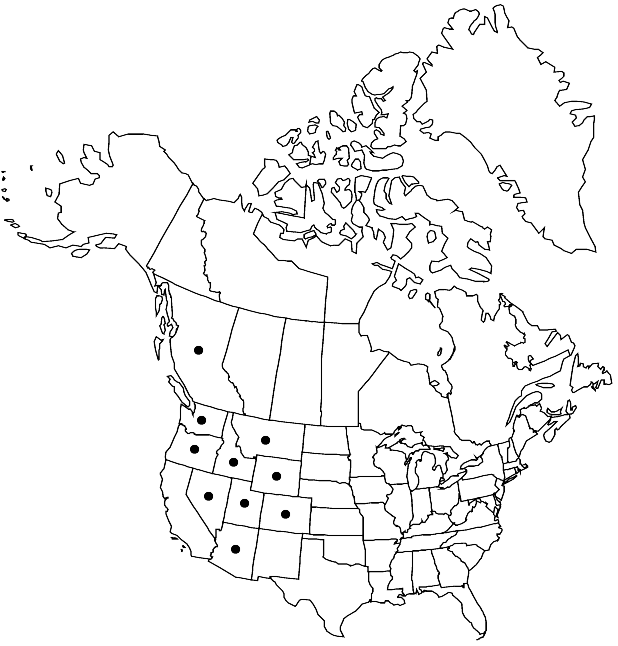Difference between revisions of "Descurainia longepedicellata"
in H. G. A. Engler, Pflanzenr. 86[IV,105]: 324. 1924.
FNA>Volume Importer |
FNA>Volume Importer |
||
| Line 7: | Line 7: | ||
|year=1924 | |year=1924 | ||
}} | }} | ||
| − | |basionyms={{Treatment/ID/ | + | |basionyms={{Treatment/ID/Basionym |
|name=Sisymbrium longepedicellatum | |name=Sisymbrium longepedicellatum | ||
|authority=E. Fournier | |authority=E. Fournier | ||
| + | |publication_title=Recherches Anat. Taxon. Fam. Crucifèr., | ||
| + | |publication_place=59. 1865 | ||
}} | }} | ||
|synonyms={{Treatment/ID/Synonym | |synonyms={{Treatment/ID/Synonym | ||
| Line 74: | Line 76: | ||
|elevation=200-2100 m | |elevation=200-2100 m | ||
|distribution=B.C.;Ariz.;Colo.;Idaho;Mont.;Nev.;Oreg.;Utah;Wash.;Wyo. | |distribution=B.C.;Ariz.;Colo.;Idaho;Mont.;Nev.;Oreg.;Utah;Wash.;Wyo. | ||
| − | |discussion=<p>L. E. Detling (1939) treated <i>Descurainia longepedicellata</i> as <i></i>subsp.<i> filipes</i> of <i>D. pinnata</i>, whereas R. C. Rollins (1993) and N. H. Holmgren (2005b) treated it as a subspecies and variety, respectively, of <i>D. incisa</i>. Molecular data, both nuclear and plastidic (B. E. Goodson 2007), place the three taxa in different, well-supported clades.</p><!-- | + | |discussion=<p>L. E. Detling (1939) treated <i>Descurainia longepedicellata</i> as <i></i></i>subsp.<i><i> filipes</i> of <i>D. pinnata</i>, whereas R. C. Rollins (1993) and N. H. Holmgren (2005b) treated it as a subspecies and variety, respectively, of <i>D. incisa</i>. Molecular data, both nuclear and plastidic (B. E. Goodson 2007), place the three taxa in different, well-supported clades.</p><!-- |
--><p>R. C. Rollins (1993) and N. H. Holmgren (2005b) reported 2n = 28 and 42 for <i>Descurainia longepedicellata</i> (as <i>D. pinnata</i> var. filipes), but these counts are not vouchered. Rollins indicated that the taxon range extends into California and New Mexico; we have not seen material from those states.</p><!-- | --><p>R. C. Rollins (1993) and N. H. Holmgren (2005b) reported 2n = 28 and 42 for <i>Descurainia longepedicellata</i> (as <i>D. pinnata</i> var. filipes), but these counts are not vouchered. Rollins indicated that the taxon range extends into California and New Mexico; we have not seen material from those states.</p><!-- | ||
--><p><i>Descurainia longepedicellata</i> resembles <i>D. incisa </i>subsp.<i> paysonii</i> in having long fruiting pedicels and linear leaf lobes with entire margins. The latter is easily distinguished by being canescent (versus not canescent) and having fruits strongly curved inward (versus straight). Because the two taxa are not closely related (B. E. Goodson 2007), the similarities in fruiting pedicels and distalmost leaf segments represent convergence.</p> | --><p><i>Descurainia longepedicellata</i> resembles <i>D. incisa </i>subsp.<i> paysonii</i> in having long fruiting pedicels and linear leaf lobes with entire margins. The latter is easily distinguished by being canescent (versus not canescent) and having fruits strongly curved inward (versus straight). Because the two taxa are not closely related (B. E. Goodson 2007), the similarities in fruiting pedicels and distalmost leaf segments represent convergence.</p> | ||
| Line 100: | Line 102: | ||
|publication year=1924 | |publication year=1924 | ||
|special status= | |special status= | ||
| − | |source xml=https://jpend@bitbucket.org/aafc-mbb/fna-data-curation.git/src/ | + | |source xml=https://jpend@bitbucket.org/aafc-mbb/fna-data-curation.git/src/f6b125a955440c0872999024f038d74684f65921/coarse_grained_fna_xml/V7/V7_826.xml |
|tribe=Brassicaceae tribe Descurainieae | |tribe=Brassicaceae tribe Descurainieae | ||
|genus=Descurainia | |genus=Descurainia | ||
Revision as of 20:24, 24 September 2019
Annuals; usually eglandular, rarely glandular; moderately to sparsely pubescent, often glabrous distally, not canescent, trichomes dendritic. Stems erect, unbranched or branched proximally, often branched distally, (1.5–)3–6.2(–8.5) dm. Basal leaves: petiole 0.4–3.5 cm; blade pinnate, ovate to oblanceolate in outline, 1.5–7 cm, lateral lobes linear or oblong, margins entire or dentate to incised. Cauline leaves sessile or shortly petiolate; blade smaller distally, lobes linear to filiform, margins entire, surfaces usually glabrous, rarely pubescent. Racemes considerably elongated in fruit. Fruiting pedicels horizontal to divaricate, straight, (8–)10–15(–20) mm. Flowers: sepals ascending, yellow, oblong, 1.5–2 mm, glabrous; petals narrowly oblanceolate, 1.7–2.6 cm × 0.5–1 mm; median filaments 1.5–2 mm; anthers 0.3–0.4 mm. Fruits erect, linear, not torulose, (9–)12–17 × 0.8–1.1 mm, (straight or slightly curved inward); valves each with obscure midvein; septum not veined; ovules 18–32 per ovary; style 0.1–0.2 mm, glabrous. Seeds uniseriate, reddish brown, oblong, 1–1.3 × 0.6–0.7 mm. 2n = 14.
Phenology: Flowering Apr–Jul.
Habitat: Sandy plains and banks, dry washes, open hillsides, sagebrush and juniper or pine communities, grasslands
Elevation: 200-2100 m
Distribution

B.C., Ariz., Colo., Idaho, Mont., Nev., Oreg., Utah, Wash., Wyo.
Discussion
L. E. Detling (1939) treated Descurainia longepedicellata as subsp. filipes of D. pinnata, whereas R. C. Rollins (1993) and N. H. Holmgren (2005b) treated it as a subspecies and variety, respectively, of D. incisa. Molecular data, both nuclear and plastidic (B. E. Goodson 2007), place the three taxa in different, well-supported clades.
R. C. Rollins (1993) and N. H. Holmgren (2005b) reported 2n = 28 and 42 for Descurainia longepedicellata (as D. pinnata var. filipes), but these counts are not vouchered. Rollins indicated that the taxon range extends into California and New Mexico; we have not seen material from those states.
Descurainia longepedicellata resembles D. incisa subsp. paysonii in having long fruiting pedicels and linear leaf lobes with entire margins. The latter is easily distinguished by being canescent (versus not canescent) and having fruits strongly curved inward (versus straight). Because the two taxa are not closely related (B. E. Goodson 2007), the similarities in fruiting pedicels and distalmost leaf segments represent convergence.
Selected References
None.